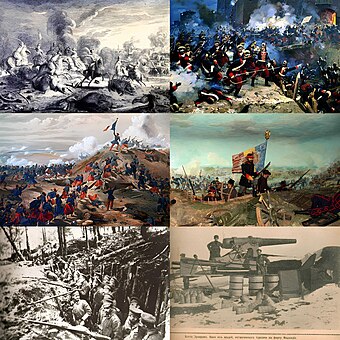
Back الحروب الروسية العثمانية Arabic Рус-төрөк һуғыштары Bashkir Руска-турэцкія войны Byelorussian Руско-турски войни Bulgarian Brezelioù etre Rusia ha Turkia Breton Història de les guerres russo-turques Catalan Rusko-osmanské války Czech De russisk-tyrkiske krige Danish Russisch-Türkische Kriege German Ρωσοτουρκικοί πόλεμοι Greek
Russo-Turkish wars (Russian: Русско-турецкие войны, romanized: Russko-turetskiye voyny) or Russo-Ottoman wars (Turkish: Osmanlı-Rus savaşları) were a series of twelve wars fought between the Russian Empire and the Ottoman Empire between the 16th and 20th centuries. It was one of the longest series of military conflicts in European history.[3] Except for the war of 1710–11, as well as the Crimean War which is often treated as a separate event, the conflicts ended disastrously for the Ottoman Empire, which was undergoing a long period of stagnation and decline; conversely, they showcased the ascendancy of Russia as a European power after the modernization efforts of Peter the Great in the early 18th century.[4][5][6]
- ^ Zayonchkovski, Аndrey (2002). Восточная война 1853-1856 [The Eastern War of 1853-1856] (in Russian). St. Petersburg: Piter. ISBN 978-5-89173-159-2.
- ^ a b #List of conflicts
- ^ Cite error: The named reference
Dowlngwas invoked but never defined (see the help page). - ^ Ágoston, G. (2011). "Military Transformation in the Ottoman Empire and Russia, 1500–1800". Kritika: Explorations in Russian and Eurasian History. 12 (2). Slavica Publishers: 281–319. doi:10.1353/kri.2011.0018. ISSN 1538-5000. S2CID 19755686.
- ^ Kafadar, C. (1999). "The Question of Ottoman Decline". Harvard Middle East and Islamic Review. 4 (1–2).
- ^ Howard, D. A. (1988). "Ottoman Historiography and the Literature of Decline of the Sixteenth and Seventeenth Centuries". Journal of Asian History. 22 (1). Harrassowitz Verlag: 52–77.
Cite error: There are <ref group=lower-alpha> tags or {{efn}} templates on this page, but the references will not show without a {{reflist|group=lower-alpha}} template or {{notelist}} template (see the help page).
© MMXXIII Rich X Search. We shall prevail. All rights reserved. Rich X Search
